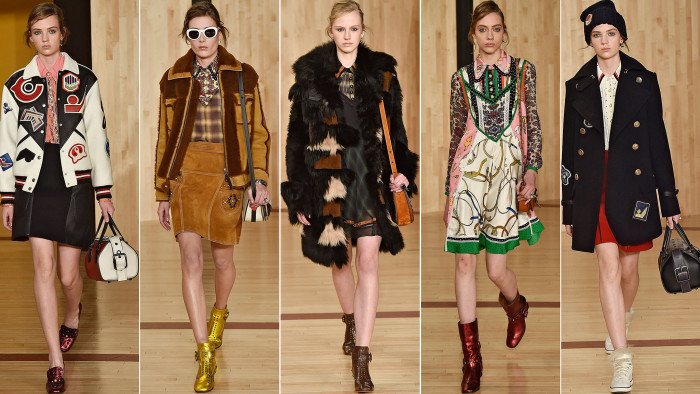Coach AW16 report New York Womenswear

Simply sign up to the Life & Arts myFT Digest -- delivered directly to your inbox.
Coach’s creative director, the British designer Stuart Vevers, is entering his third year at the American house and the brand’s re-emergence as a viable ready-to-wear label is beginning to bear fruit. Results announced at the end of the third quarter saw a net sales growth of 4 per cent and a total sales increase of 7 per cent on a constant currency basis. After a grim year of double digit downs, the brand is finally on an upward trajectory.
It has been a long haul with lots of shop closures, a radical redesign of the house codes and the introduction of a ready-to-wear show that has placed the 75-year-old house at the centre of New York fashion week. Vevers’ vision, meanwhile, has found some real traction among the fashion cognoscenti. His distinctive shearling jackets have been spotted on fashionable backs all over the city this week and his interpretation of cool Americana is increasingly visible. With a few cleverly considered pieces — I might even describe his coats as “cult” — Vevers has given Coach a welcome jolt of fashionability.
That said, this is no easy climate to work in. Vevers has passed the two-year mark that claimed his contemporaries Raf Simons at Dior and Alexander Wang at Balenciaga, both designers who brought a shortlived new vision to their respective houses. Creative leadership can be a fleeting thing. Is Vevers watching the clock? No way.
“There’s still so much to do,” he explained the day before the show at the company’s headquarters. “But I’m feeling really optimistic about the direction we’re moving in. We’ve touched some early success because we’ve developed a nostalgia for our brand which I think has a real authenticity about it. We’re only young comparatively but we’re one of the few genuine heritage labels in the US and I think we’re developing that heritage in a positive way.”
In many ways Vevers’ pseudo-retro aesthetic echoes the same principles that have also rebooted Alessandro Michele’s Gucci. By looking through the archives and drawing on a strict code of Coach motifs, Vevers has developed a line of vintage-seeming, collegiate clothes and accessories that look like they might have always been part of the house. Michele calls his quasi-archival aesthetic “fake vintage” and it is as good a description as any to apply to Coach where Vevers can mine a rich seam of American cultural references and claim them as Coach’s own.
For AW16, he had drawn on old portraits: a teenage Jodie Foster, Youngbloods (the 1986 ice-hockey drama starring Rob Lowe), Scooby Doo’s Thelma and 1980s music act Salt-N-Pepa to inform a collection of bold, primary printed varsity jackets (all decorated in college badges), navy peacoats, plaid shirtdresses (rematerialised in a saucy crêpe de chine with pearl button bib fronts), a shearling Revenant coat (tufted into a bearish fluff to seem more antique and pioneer-like), biker jackets and an army of metallic-coloured, buckled, studded booties. The set was styled like a gymnasium: scene of so many iconic high school movies. I spent a lot of time thereafter Googling pictures of Rob Lowe.
Vevers isn’t reinventing the wheel here. His preppy, cheery aesthetic echoes many of the themes US brands are built on. Tommy Hilfiger the day before had delivered a “cruise” collection with similarly collegiate naval coats, retro prints and badges. Marc Jacobs has always called on the high school rebel as his muse, while Ralph Lauren invented sorority chic. Even so, Vevers’ collection was pretty, practical, fresh and feminine — it felt authentic.
Meanwhile, his response to the “see now buy now” trend was to offer three “Rogue” bags for sale immediately after the show. Vevers has not made his mind up about insta-fashion yet. “I’ve got a lot of questions,” he told me. “Firstly, the ready-to-wear is already a new proposition for the house and I’m not sure how many streams we want to open all at once. Secondly, when is continental Europe going to engage with the idea? And lastly, how will it all work in terms of presentation and editorial?”
Knocking out a few extra bags is not such a massive undertaking for a house such as Coach, which has the capital and infrastructure to turn around such orders within a relatively short time. Vevers had decided to insta-sell the Rogue bags two months ago and his manufacturers had not blinked an eyelid. Creatively, however, it is a thornier discussion. “It could be really interesting,” said Vevers, “but there’s still no substitute for the creative energy you feel when you’re working to a deadline. Things that happen in the week before a show are the points at which it all comes together. I can’t quite imagine how I’d work that creativity within an environment when sales and manufacture were all happening simultaneously and with press appointments and showings going on all the time. I love the clean sweep of a collection and the chance to start another season anew.”
I’ll second that.
For more reports from the shows, go to our fashion weeks page
Photographs: Catwalking.com
Comments